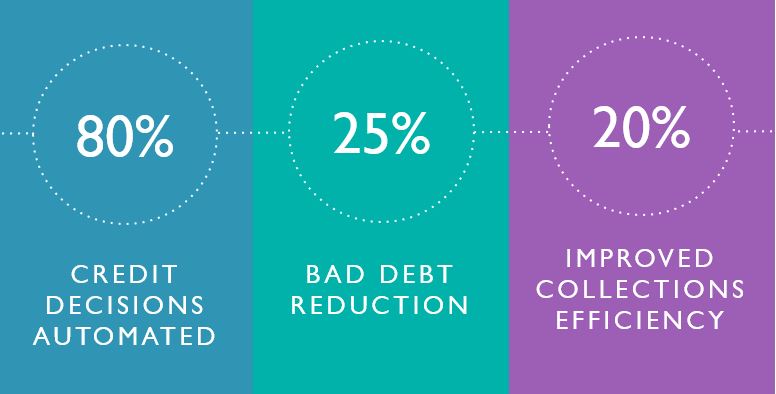Custom Risk Analytics Models Speed Profitable Growth
When it comes to processing business credit card applications, every second counts. Applicants expect an instant decision, which can leave providers little time to perform a comprehensive risk assessment. Questions such as “Is this company legitimate?” “How much credit should we extend?” and “Will this company pay its monthly bill on time?” need to be answered quickly, and with the right data.
The Challenge: Scaling the Credit Application Process from 3,000 Decisions a Month to 7,000
One Dun & Bradstreet customer, a leading provider of private label credit cards, experienced major growth after winning the contract to issue and operate cards for a major retailer. Their number of applications jumped from around 3,000 per month to over 7,000 per month. To make credit decisions, the company had been using standard, “off-the-shelf” scoring models from Dun & Bradstreet and another industry provider; they also performed more labor-intensive manual reviews on smaller populations of applications.
The standard scoring models were a viable option for the company when application numbers were much lower and more easily processed within a limited technical environment, but now that growth had changed all of that, what was the plan? More employees?
“That's not scalable. We can't hire an army to do that; it's inefficient. How are we going to meet this onslaught of increasing volume of applications while being more efficient?” the company’s Chief Risk Officer said.
As the volume of credit decisions increased, so did the need for unmatched accuracy and API integration in the processing phase. (API – application program interface – directly feeds decisioning data about the applicant into its systems, so there’s no need for separate software systems to perform the different functions needed to process card applications.)
The credit team needed more precise models that would give them the data, freedom, and confidence necessary to streamline the process and move to a wholly automated application review and determination equation. As a result, the company moved away from standard scoring models and engaged Dun & Bradstreet’s Advanced Analytics Team to create a more complete and customized automated solution.
The Solution: Automating Credit Decisions with Integrated Predictive Risk Insights
Based upon the rapidly increasing number of applications and the desire for a hosted, more precise and predictive model, the customer met with Dun & Bradstreet to discuss their need to increase automated approval rates to gain efficiency and scale.
Customized analytics models, leveraging data from the Dun & Bradstreet Data Cloud were the answer. The Dun & Bradstreet Data Cloud delivers the world's most comprehensive business data and insights to improve performance, comprised of over hundreds of millions business records, each containing thousands of attributes, including firmographic data and trade payment data.
The customized models leverage other data sources, including continuously monitored data, to provide more precise predictive scores. The models include the full spectrum of the Data Cloud’s detailed payment performance data, as well as two separate small business data repositories – Dun & Bradstreet’s own Small Business Risk Insight® (SBRI) and the Small Business Financial Exchange™ (SBFE), a third-party consortium.
Dun & Bradstreet created a suite of completely custom analytic models that allowed the company’s credit team to quickly score new applicants and active customers with precision. The move from a standardized analytic model to custom ones afforded it the accuracy necessary to continue its unprecedented growth by tapping into predictive insights with confidence.
“Anytime we can get a lift in either approval rates or match rates or efficiency, turnaround time, anything like that, it's going to be worth it,” he said.
The custom analytic models support their account approval and credit management program. The models produce proprietary scores, which the company uses to predict the likelihood of a new applicant becoming delinquent within 12 months of activation, recommend a credit limit, and conduct credit maintenance over an ongoing 18-month time frame. In addition, to extend analytics across the full credit lifecycle, Dun & Bradstreet has proposed a custom collections scoring model to rank, order, and prioritize past due accounts for collection activities.
The Results: Scaling Credit Decision Efficiency and Decreasing Bad Debt by 25% Leads to Profitable Growth
“Since putting the new models in production, we’ve reduced bad debt by 25%, increased automated decision rates from 0% to over 80%, and increased operational and collection efficiency by about 20%,” he said.
Since implementation, the company has experienced positive results: quicker turnaround times, greater efficiency and accuracy, and the complete automation of the application process without adding additional staff—which has been a game-changer.
“Because of the models Dun & Bradstreet put together for us, in almost every case the early warning signal was the most predictive and was able to say, ‘Watch out - this account's headed for trouble.’ So, we were able to use that score, take action, reduce our exposure, reduce the credit lines and really mitigate our risk through that score,” he said.
At Dun & Bradstreet, predictive data and insights are also supported by best-in-class service. Dun & Bradstreet hosts the models on its side of the firewall, which reduces dependence upon the customer’s IT team. The strategic relationship covers all aspects of short- and long-term needs and gives the company access to comprehensive data as well as analytical and project management expertise. Dun & Bradstreet and the customer’s teams also meet twice a week to proactively ensure success through ongoing maintenance, monitoring, and edited implementation of the models.
“One of the reasons the custom models have been working so well is because Dun & Bradstreet has really helped us with their expertise and hosting it, and then we're nimbler with what we can do,” he said.

